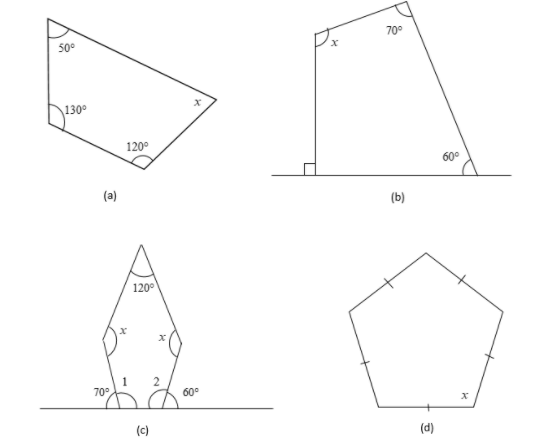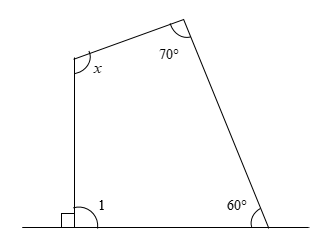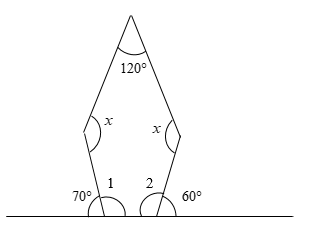
Find the angle measure of \[x\] in the following figures:


Answer
554.1k+ views
Hint: Here, we need to find the value of \[x\] in the given figures. We will use the angle sum property of a quadrilateral to find the value of \[x\] in first figures. Then we will use the properties of linear pair angles to find the angle in the third figure. We will then use the angle sum property of a pentagon to find the value of \[x\] in the fourth figure.
Complete step-by-step answer:
(a)
The sum of all the interior angles of a quadrilateral is equal to \[360^\circ \].
Therefore, we get
\[50^\circ + 130^\circ + 120^\circ + x = 360^\circ \]
This is a linear equation in terms of \[x\]. We will solve this equation to find the value of \[x\].
Adding the terms of the equation, we get
\[ \Rightarrow 300^\circ + x = 360^\circ \]
Subtracting \[300^\circ \] from both sides of the equation, we get
\[ \Rightarrow 300^\circ + x - 300^\circ = 360^\circ - 300^\circ \]
Thus, we get
\[ \Rightarrow x = 60^\circ \]
Therefore, we get the value of \[x\] as \[60^\circ \].
(b)
First, we will mark another angle in the figure.

The sum of all the angles lying on a line is equal to \[180^\circ \]. These angles are said to form a linear pair.
From the figure, we can observe that the right angle and angle 1 form a linear pair.
Therefore, we get
\[90^\circ + \angle 1 = 180^\circ \]
Subtracting \[90^\circ \] from both sides of the equation, we get
\[\begin{array}{l} \Rightarrow 90^\circ + \angle 1 - 90^\circ = 180^\circ - 90^\circ \\ \Rightarrow \angle 1 = 90^\circ \end{array}\]
The sum of all the interior angles of a quadrilateral is equal to \[360^\circ \].
Therefore, we get
\[70^\circ + 60^\circ + \angle 1 + x = 360^\circ \]
This is a linear equation in terms of \[x\]. We will solve this equation to find the value of \[x\].
Substituting \[\angle 1 = 90^\circ \] in the equation, we get
\[ \Rightarrow 70^\circ + 60^\circ + 90^\circ + x = 360^\circ \]
Adding the terms of the equation, we get
\[ \Rightarrow 220^\circ + x = 360^\circ \]
Subtracting \[220^\circ \] from both sides of the equation, we get
\[ \Rightarrow 220^\circ + x - 220^\circ = 360^\circ - 220^\circ \]
Thus, we get
\[ \Rightarrow x = 140^\circ \]
Therefore, we get the value of \[x\] as \[140^\circ \].
(c)
First, we will mark two angles in the figure.

The sum of all the angles lying on a line is equal to \[180^\circ \]. These angles are said to form a linear pair.
From the figure, we can observe that the angle measuring \[70^\circ \] and angle 1 form a linear pair.
Therefore, we get
\[70^\circ + \angle 1 = 180^\circ \]
Subtracting \[70^\circ \] from both sides of the equation, we get
\[\begin{array}{l} \Rightarrow 70^\circ + \angle 1 - 70^\circ = 180^\circ - 70^\circ \\ \Rightarrow \angle 1 = 110^\circ \end{array}\]
From the figure, we can observe that the angle measuring \[60^\circ \] and angle 2 form a linear pair.
Therefore, we get
\[60^\circ + \angle 2 = 180^\circ \]
Subtracting \[60^\circ \] from both sides of the equation, we get
\[\begin{array}{l} \Rightarrow 60^\circ + \angle 2 - 60^\circ = 180^\circ - 60^\circ \\ \Rightarrow \angle 2 = 120^\circ \end{array}\]
The sum of all the interior angles of a pentagon is equal to \[540^\circ \].
Therefore, we get
\[120^\circ + x + x + \angle 1 + \angle 2 = 540^\circ \]
This is a linear equation in terms of \[x\]. We will solve this equation to find the value of \[x\].
Substituting \[\angle 1 = 110^\circ \] and \[\angle 2 = 120^\circ \] in the equation, we get
\[ \Rightarrow 120^\circ + x + x + 110^\circ + 120^\circ = 540^\circ \]
Adding the terms of the equation, we get
\[ \Rightarrow 350^\circ + 2x = 540^\circ \]
Subtracting \[350^\circ \] from both sides of the equation, we get
\[\begin{array}{l} \Rightarrow 2x = 540^\circ - 350^\circ \\ \Rightarrow 2x = 190^\circ \end{array}\]
Dividing both sides of the equation by 2, we get
\[ \Rightarrow x = 95^\circ \]
Therefore, we get the value of \[x\] as \[95^\circ \].
(d)
It is shown that all sides of the pentagon are equal.
Therefore, the given pentagon is a regular pentagon.
We know that all the sides and interior angles of a regular polygon are equal.
Therefore, we get the measure of the five interior angles as \[x\].
The sum of all the interior angles of a pentagon is equal to \[540^\circ \].
Therefore, we get
\[x + x + x + x + x = 540^\circ \]
This is a linear equation in terms of \[x\]. We will solve this equation to find the value of \[x\].
Adding the terms of the equation, we get
\[ \Rightarrow 5x = 540^\circ \]
Dividing both sides of the equation by 5, we get
\[ \Rightarrow x = 108^\circ \]
Therefore, we get the value of \[x\] as \[108^\circ \].
Note: We have formed linear equations in one variable in terms of \[x\] in the solution. A linear equation in one variable is an equation that can be written in the form \[ax + b = 0\], where \[a\] is not equal to 0, and \[a\] and \[b\] are real numbers. For example, \[x - 100 = 0\] and \[100P - 566 = 0\] are linear equations in one variable \[x\] and \[P\] respectively. A linear equation in one variable has only one solution.
We used the term ‘regular polygon’ in the solution. A polygon is a closed figure made using straight lines as sides. A regular polygon is a polygon whose interior angles and sides are equal. For example: a square is a regular polygon having 4 sides, a pentagon is a regular polygon having 5 sides, a hexagon is a regular polygon having 6 sides, etc.
Complete step-by-step answer:
(a)
The sum of all the interior angles of a quadrilateral is equal to \[360^\circ \].
Therefore, we get
\[50^\circ + 130^\circ + 120^\circ + x = 360^\circ \]
This is a linear equation in terms of \[x\]. We will solve this equation to find the value of \[x\].
Adding the terms of the equation, we get
\[ \Rightarrow 300^\circ + x = 360^\circ \]
Subtracting \[300^\circ \] from both sides of the equation, we get
\[ \Rightarrow 300^\circ + x - 300^\circ = 360^\circ - 300^\circ \]
Thus, we get
\[ \Rightarrow x = 60^\circ \]
Therefore, we get the value of \[x\] as \[60^\circ \].
(b)
First, we will mark another angle in the figure.

The sum of all the angles lying on a line is equal to \[180^\circ \]. These angles are said to form a linear pair.
From the figure, we can observe that the right angle and angle 1 form a linear pair.
Therefore, we get
\[90^\circ + \angle 1 = 180^\circ \]
Subtracting \[90^\circ \] from both sides of the equation, we get
\[\begin{array}{l} \Rightarrow 90^\circ + \angle 1 - 90^\circ = 180^\circ - 90^\circ \\ \Rightarrow \angle 1 = 90^\circ \end{array}\]
The sum of all the interior angles of a quadrilateral is equal to \[360^\circ \].
Therefore, we get
\[70^\circ + 60^\circ + \angle 1 + x = 360^\circ \]
This is a linear equation in terms of \[x\]. We will solve this equation to find the value of \[x\].
Substituting \[\angle 1 = 90^\circ \] in the equation, we get
\[ \Rightarrow 70^\circ + 60^\circ + 90^\circ + x = 360^\circ \]
Adding the terms of the equation, we get
\[ \Rightarrow 220^\circ + x = 360^\circ \]
Subtracting \[220^\circ \] from both sides of the equation, we get
\[ \Rightarrow 220^\circ + x - 220^\circ = 360^\circ - 220^\circ \]
Thus, we get
\[ \Rightarrow x = 140^\circ \]
Therefore, we get the value of \[x\] as \[140^\circ \].
(c)
First, we will mark two angles in the figure.

The sum of all the angles lying on a line is equal to \[180^\circ \]. These angles are said to form a linear pair.
From the figure, we can observe that the angle measuring \[70^\circ \] and angle 1 form a linear pair.
Therefore, we get
\[70^\circ + \angle 1 = 180^\circ \]
Subtracting \[70^\circ \] from both sides of the equation, we get
\[\begin{array}{l} \Rightarrow 70^\circ + \angle 1 - 70^\circ = 180^\circ - 70^\circ \\ \Rightarrow \angle 1 = 110^\circ \end{array}\]
From the figure, we can observe that the angle measuring \[60^\circ \] and angle 2 form a linear pair.
Therefore, we get
\[60^\circ + \angle 2 = 180^\circ \]
Subtracting \[60^\circ \] from both sides of the equation, we get
\[\begin{array}{l} \Rightarrow 60^\circ + \angle 2 - 60^\circ = 180^\circ - 60^\circ \\ \Rightarrow \angle 2 = 120^\circ \end{array}\]
The sum of all the interior angles of a pentagon is equal to \[540^\circ \].
Therefore, we get
\[120^\circ + x + x + \angle 1 + \angle 2 = 540^\circ \]
This is a linear equation in terms of \[x\]. We will solve this equation to find the value of \[x\].
Substituting \[\angle 1 = 110^\circ \] and \[\angle 2 = 120^\circ \] in the equation, we get
\[ \Rightarrow 120^\circ + x + x + 110^\circ + 120^\circ = 540^\circ \]
Adding the terms of the equation, we get
\[ \Rightarrow 350^\circ + 2x = 540^\circ \]
Subtracting \[350^\circ \] from both sides of the equation, we get
\[\begin{array}{l} \Rightarrow 2x = 540^\circ - 350^\circ \\ \Rightarrow 2x = 190^\circ \end{array}\]
Dividing both sides of the equation by 2, we get
\[ \Rightarrow x = 95^\circ \]
Therefore, we get the value of \[x\] as \[95^\circ \].
(d)
It is shown that all sides of the pentagon are equal.
Therefore, the given pentagon is a regular pentagon.
We know that all the sides and interior angles of a regular polygon are equal.
Therefore, we get the measure of the five interior angles as \[x\].
The sum of all the interior angles of a pentagon is equal to \[540^\circ \].
Therefore, we get
\[x + x + x + x + x = 540^\circ \]
This is a linear equation in terms of \[x\]. We will solve this equation to find the value of \[x\].
Adding the terms of the equation, we get
\[ \Rightarrow 5x = 540^\circ \]
Dividing both sides of the equation by 5, we get
\[ \Rightarrow x = 108^\circ \]
Therefore, we get the value of \[x\] as \[108^\circ \].
Note: We have formed linear equations in one variable in terms of \[x\] in the solution. A linear equation in one variable is an equation that can be written in the form \[ax + b = 0\], where \[a\] is not equal to 0, and \[a\] and \[b\] are real numbers. For example, \[x - 100 = 0\] and \[100P - 566 = 0\] are linear equations in one variable \[x\] and \[P\] respectively. A linear equation in one variable has only one solution.
We used the term ‘regular polygon’ in the solution. A polygon is a closed figure made using straight lines as sides. A regular polygon is a polygon whose interior angles and sides are equal. For example: a square is a regular polygon having 4 sides, a pentagon is a regular polygon having 5 sides, a hexagon is a regular polygon having 6 sides, etc.
Recently Updated Pages
Master Class 9 Social Science: Engaging Questions & Answers for Success

Master Class 9 Science: Engaging Questions & Answers for Success

Master Class 9 English: Engaging Questions & Answers for Success

Master Class 9 Maths: Engaging Questions & Answers for Success

Master Class 11 Economics: Engaging Questions & Answers for Success

Master Class 11 English: Engaging Questions & Answers for Success

Trending doubts
Which places in India experience sunrise first and class 9 social science CBSE

Fill the blanks with the suitable prepositions 1 The class 9 english CBSE

Write the 6 fundamental rights of India and explain in detail

Difference Between Plant Cell and Animal Cell

What is the Full Form of ISI and RAW

Golden Revolution is related to AFood production BOil class 9 social science CBSE




